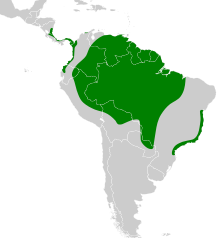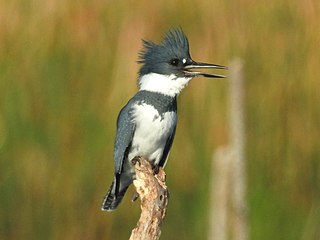
The belted kingfisher is a large, conspicuous water kingfisher, native to North America. All kingfishers are placed in one family, Alcedinidae, and recent research suggests that this should be divided into three subfamilies.

The common kingfisher, also known as the Eurasian kingfisher and river kingfisher, is a small kingfisher with seven subspecies recognized within its wide distribution across Eurasia and North Africa. It is resident in much of its range, but migrates from areas where rivers freeze in winter.

The pied kingfisher is a species of water kingfisher widely distributed across Africa and Asia. Originally described by Carl Linnaeus in 1758, it has five recognised subspecies. Its black and white plumage and crest, as well as its habit of hovering over clear lakes and rivers before diving for fish, make it distinctive. Males have a double band across the breast, while females have a single broken breast band. They are usually found in pairs or small family groups. When perched, they often bob their head and flick up their tail.
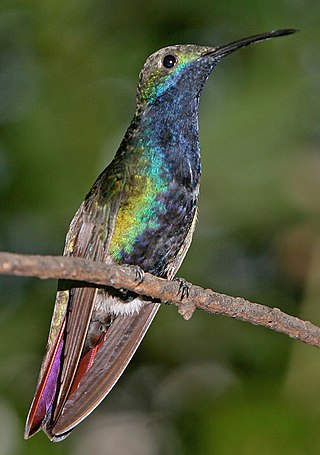
The black-throated mango is a species in subfamily Polytminae of the hummingbird family Trochilidae. It is found in Panama, in every mainland South American country except Chile, and in Trinidad and Tobago.

The green kingfisher is a species of "water kingfisher" in the subfamily Cerylinae of the family Alcedinidae. It is found from southern Texas in the United States south through Central America, in every mainland South American country except Chile and Trinidad and Tobago.

The blue-tailed emerald is a hummingbird in the "emeralds", tribe Trochilini of subfamily Trochilinae. It is found in tropical and subtropical South America east of the Andes from Colombia east to the Guianas and Trinidad, and south to northern Bolivia and central Brazil.
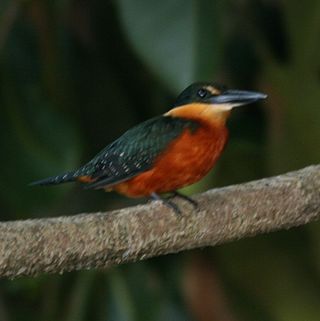
The American green kingfishers are the kingfisher genus Chloroceryle, which are native to tropical Central and South America, with one species extending north to south Texas.

Megaceryle is a genus of very large kingfishers. They have a wide distribution in the Americas, Africa, and Southeast Asia.

The Amazon kingfisher is a species of "water kingfisher" in subfamily Cerylinae of family Alcedinidae. It is found in the lowlands of the American tropics from southern Mexico south through Central America to northern Argentina.

The American pygmy kingfisher is a species of "water kingfisher" in subfamily Cerylinae of family Alcedinidae. It is found in the American tropics from southern Mexico south through Central America into every mainland South American country except Chile and Uruguay. It also occurs on Trinidad.
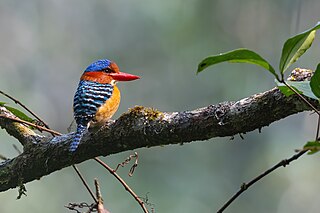
The banded kingfisher is a tree kingfisher found in lowland tropical forests of southeast Asia. It is the only member of the genus Lacedo. Male and female adults are very different in plumage. The male has a bright blue crown with black and blue banding on the back. The female has rufous and black banding on the head and upperparts.

The rufous nightjar is a species of nightjar in the family Caprimulgidae. It is found in Argentina, Bolivia, Brazil, Colombia, Costa Rica, Ecuador, Guyana, Panama, Paraguay, Peru, Saint Lucia, Suriname, Trinidad and Tobago, and Venezuela.

The rufous-vented ground cuckoo is a Vulnerable species of cuckoo in the tribe Neomorphini of subfamily Crotophaginae. It is found in Bolivia, Brazil, Colombia, Costa Rica, Ecuador, Nicaragua, Panama, and Peru.

The Malagasy kingfisher or Madagascar kingfisher is a species of bird in the family Alcedinidae that is found in Madagascar, Mayotte and the Comoros. Its natural habitat is subtropical or tropical mangrove forests.

The black-backed dwarf kingfisher, also known as the three-toed kingfisher, is a pocket-sized bird in the family Alcedinidae. It was formerly considered as conspecific with the rufous-backed dwarf kingfisher and together the species complex was known by the English name "oriental dwarf kingfisher".

The Society kingfisher or Tahiti kingfisher is a species of bird in the family Alcedinidae. It is endemic to the Society Islands of French Polynesia. Its natural habitats are subtropical or tropical moist lowland forest and subtropical or tropical moist montane forest.

Winchell's kingfisher or the rufous-lored kingfisher, is a species of bird in the family Alcedinidae, the kingfishers. It is endemic to the Philippines, its natural habitat being lowland forests. It is threatened by deforestation, and the International Union for Conservation of Nature (IUCN) has assessed it as a vulnerable species.

The ringed woodpecker is a species of bird in subfamily Picinae of the woodpecker family Picidae. It is found in every mainland South American country except Argentina, Chile, Paraguay, and Uruguay.

The waved woodpecker is a species of bird in subfamily Picinae of the woodpecker family Picidae. It is found in Bolivia, Brazil, Colombia, Ecuador, French Guiana, Guyana, Peru, Suriname, and Venezuela.
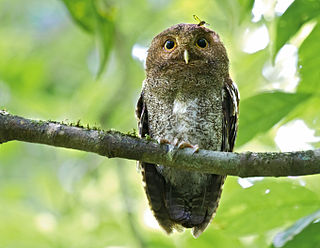
The vermiculated screech owl, is a subspecies, or possibly separate species, of owl in the family Strigidae. It is found in Costa Rica, Nicaragua, and Panama.

